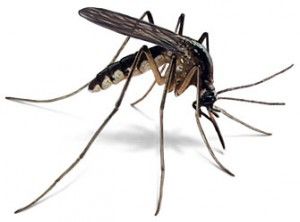By Dr. Patrick Mahaney, VMD
Heartworm is a preventable but potentially life-threatening disease spread by the bite of a mosquito carrying the blood-borne parasite. When a mosquito bites a heartworm-positive animal, it carries the heartworm parasite to the next animal it bites, who can then become infected.
The treatment for heartworm disease is typically arsenic-based, which can be very toxic for the body and is generally unpleasant for the pet. Understanding and preventing heartworm infection will keep your pet from having to suffer from the symptoms and treatment of heartworm disease.
4 Stages of Heartworm Disease Heartworm is the common name for Dirofilaria immitis, a parasitic nematode or roundworm. The 4 classes of heartworm disease have increasingly severe symptoms with each class.
- Class I - Pets with Class I heartworm disease show no to very few signs of illness,
 such as a mild cough.
such as a mild cough. - Class II - Pets affected by Class II heart disease are prone to coughing, exercise intolerance, weight loss, and a generally unkempt appearance.
- Class III - More severe clinical signs during Class III heartworm disease include anemia, respiratory difficulty, and right-sided heart failure.
- Class IV - A pet with Class IV disease has episodes of collapse, shock, and multi-organ system failure.
At-Risk Areas Include Warm, Humid Regions
 Heartworm disease is very common in warm, humid climates. On the southeast coast of the U.S., mosquitoes are seemingly present on a year-round basis. In the northeast coastal region, mosquitoes are more seasonal and thrive in summer and fall.
Heartworm disease is very common in warm, humid climates. On the southeast coast of the U.S., mosquitoes are seemingly present on a year-round basis. In the northeast coastal region, mosquitoes are more seasonal and thrive in summer and fall.
Heartworm disease is still a problem even in regions not near the ocean. For example, I live in Los Angeles, where it is commonly warm but not very humid. The County of Los Angeles Department of Public Health reports heartworm disease as being uncommon here, but there are wild populations of coyotes that can harbor the parasite, and many domestic animals have been displaced here from other heartworm-prevalent areas.
Do you and your pets live in a heartworm-endemic area? Check out this map from the HeartwormSociety.org Heartworm Incidence in 2010.
Prevent Disease with a Monthly Heartworm Pill
Even though heartworm disease is not common in Southern California, I still suggest a  monthly heartworm preventative for my patients. It’s quite easy to get most dogs to take a monthly heartworm pill, either by itself or with the aid of a pill pocket or piece of cheese.
monthly heartworm preventative for my patients. It’s quite easy to get most dogs to take a monthly heartworm pill, either by itself or with the aid of a pill pocket or piece of cheese.
I would recommend a heartworm preventative to all pets, no matter their age. However, there is one exception. If a dog is diagnosed with a terminal disease and is suffering from the illness or treatment of the disease and has only days to weeks to live, there’s no need for a heartworm pill.
Heartworm Disease Affects Cats, Too
Heartworm disease is commonly thought of as a disease that only affects dogs. While most cats in the U.S. typically live a safer indoor existence than dogs who enjoy time inside and outside, our feline friends are still at risk for heartworm disease.
Outside or inside/outside cats are especially at risk for heartworm disease. According to the American Heartworm Society page on Feline Heartworm Disease:
According to the American Heartworm Society page on Feline Heartworm Disease:
“Although outdoor cats are at greater risk of being infected, a relatively high percentage of cats considered by their owners to be totally indoor pets also become infected. Overall, the distribution of feline heartworm infection in the United States seems to parallel that of dogs but with lower total numbers. There is no predictable age in cats for becoming infected with heartworms. Cases have been reported in cats from 9 months to 17 years of age, with the average being 4 years at diagnosis or death.”
Cats with heartworm disease can appear as though they have feline asthma. The diagnosis could be missed if the appropriate diagnostics aren’t performed, including blood testing, x-rays, and trans-tracheal wash for cytologic evaluation.
Steps Toward Prevention
How can you help protect your dog or cat from heartworm disease?
- Use window screens and keep doors and windows closed. This reduces exposure to mosquitoes that carry heartworm and other diseases.
- Take your pet to the vet for an annual physical exam.
- Follow your vet’s recommendations for heartworm testing and prevention.
- Make sure your pet isn’t heartworm positive before using a monthly preventative. Tell your vet if your pet already has heartworm disease or has not been consistently given a monthly preventative. When used in a heartworm-positive pet, the preventative will kill large numbers of the larval form of the parasite, causing a life-threatening toxic response.
How can you tell if your pet has heartworm disease? The most common test is a simple blood evaluation for the heartworm antigen, a toxin that activates your pet’s immune response. Sometimes infection with only a few worms or only female heartworms won’t be detected with this blood test. A more thorough check pairs the antigen test with a blood smear, x-ray, ultrasound, or antibody test which checks for proteins produced in response to antigens. Ask your vet about the best testing options for your pet.
If your pet tests negative (hopefully so!), use a monthly veterinary-prescribed heartworm preventative such as milbemycin, ivermectin, moxidectin, or selamectin. If your pet tests positive, your vet will discuss your next steps for treatment. In the case of heartworm disease, prevention is truly the best medicine, as untreated heartworm-infected dogs or cats will suffer potentially irreversible and life-threatening health consequences. Get your pet checked today!





